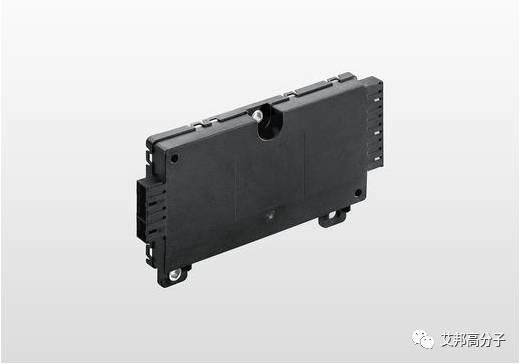特殊化學品公司朗盛和德國海拉胡克集團公司合作開發了一種名為Pocan AF4130的新型復合材料,用作電池管理單元(BMU)和兩個單元監控單元(CMU)的外殼材料。
聚對苯二甲酸丁二醇酯(PBT)和丙烯酸酯-苯乙烯-丙烯腈(ASA)的共混物含有30%(按重量計算)的玻璃纖維和鹵素阻燃劑包。該材料的特殊優點是其極低的翹曲和收縮,加上其高阻燃性。Lanxess高性能材料(HPM)業務部門的銷售總監Marc Marbach表示:“我們認為這種材料在汽車電池系統精密零部件的應用潛力很大。”從最初的想法到廣泛的測試,再到可以用于全面的生產,只用了兩年半的時間。
海拉為德國汽車電池制造商生產BMU和CMU。目前這種非常平坦的設備正在德國小型車的鋰離子電池系統中使用。

圖 海拉為德國汽車電池制造商生產BMU和CMU
偏差低
BMU和CMU的外殼具有大的平坦表面以及具有復雜幾何形狀的邊緣和內部。由于其創新的設計,BMU和CMU的外殼可以成本有效地作為單一組件注塑成型。當外殼安裝在印刷電路板上時,連接器的接觸端不能混在一起。因此,連接器支架與插腳的切口之間的間距公差是非常接近的。“這正是我們的混合物Pocan AF4130出色的尺寸穩定性所在。”Marbach解釋說。
UL 94 5VA和UL f1
該材料在美國測試機構保險商實驗室公司的UL94防火測試中獲得了V-0(0.75毫米)的最佳阻燃等級。UL黃卡上也顯示該材料UL94防火等級為5VA(1.5mm)。
該材料用于阻燃外殼部件的注射成型。另外UL f1數據顯示,該材料還可用于涉及暴露于UV光線和水的戶外應用中。Marbach補充說:“我們的復合材料也可用于光伏插頭和插座之類的電氣部件上。”
低揮發性和可容許范圍內的排放量
Lanxess根據VDA 278標準(德國汽車工業協會)進行的熱解吸分析所證明的,這種材料表面由熱塑性塑料制作成型,排放非常低。“因此,它也適用于需要非常低揮發性和可容許范圍內排放的許多汽車應用,例如汽車內飾部。”Marbach表示。
對常見電池電解質有良好的抵抗性
該混合物對機動車輛中使用的典型介質(如燃料,油,清潔劑和汽車護理產品)具有很強的抵抗能力,這在Lanxess為海拉胡克進行的廣泛的介質儲存測試中得到證實,符合供應規范LV 124,這一被許多汽車制造商認定的標準。該材料還顯示出對廣泛用于鋰離子電池的電解質的良好抗性,對此也按DIN EN22088-3進行了負載測試。“樣品即使在1,000小時的曝光后也沒有明顯的裂縫,還可以使用。”Marbach表示。
綜合性的HiAnt服務
Lanxess在研發外殼組件方面為海拉胡克提供了額外的支持。這些服務是HiAnt客戶服務包的一部分。例如,HPM提供了優化組件設計的建議,提供所有外殼組件電腦輔助設計是需要的材料性能數據以滿足預期負載并進行模流分析,幫助進行起初的注塑成型試驗。這家特種化學品公司進一步通過離子色譜法為Hella確定了混合物中鹵化物含量,并對VDA 270進行了氣味測試。
LANXESS launches new PBT compound for battery components in electric cars Specialty chemicals company LANXESS has developed a new compound called Pocan AF4130 in collaboration with HELLA KGaA Hueck & Co., based in Lippstadt, Germany. It serves as a housing material for a battery management unit (BMU) and two cell monitoring units (CMU). The blend of polybutylene terephthalate (PBT) and acrylic ester-styrene-acrylonitrile (ASA) contains 30 percent by weight glass fibers and a halogen-based flame retardance package. “The particular advantages of the material are its extremely low warpage and shrinkage, combined with its high flame retardance. We see great potential for application in precision components for vehicle battery systems,” says Marc Marbach, head of Sales Segments E&E in the LANXESS High Performance Materials (HPM) business unit. It took just two-and-a-half years to go from the initial idea to extensive testing and finally to use in full-scale production. HELLA fabricates the BMU and CMUs for a German manufacturer of battery systems for motor vehicles. The very flat devices currently are used in the lithium-ion battery system of a German compact car. Low tolerances The housings of the BMU and CMUs have large, flat surfaces as well as complex geometries along the edges and on the inside. Thanks to their innovative design, they can be injection molded cost-effectively as single components. The contact pins for the connectors must not bend when the housings are mounted on the printed circuit boards. The tolerances for the spacing between the connector mounts and the cut-outs for the pins are therefore extremely close. “This is precisely where the outstanding dimensional stability of our blend Pocan AF4130 pays off,” explains Marbach. UL 94 5VA- and UL f1-listed As required for this application, the material achieves the best classification of V-0 (0.75 millimeters) in UL 94 fire testing by the U.S. testing organization Underwriters Laboratories Inc. It further is listed on the UL Yellow Card with a good classification of UL 94 5VA (1.5 millimeters). The material is destined for the injection molding of flame-retardant housing components. It additionally has been given a UL f1 listing for use in outdoor applications involving exposure to UV light and water. “Our compound thus has a good chance of also being used for electrical components such as photovoltaic plugs and sockets,” says Marbach. Low volatile and condensable emissions Surfaces made of this thermoplastic are very low-emission, as demonstrated by thermal desorption analyses conducted by LANXESS in accordance with VDA 278 (German Association of the Automotive Industry). “It is therefore also suitable for many motor vehicle applications requiring very low volatile and condensable emissions, such as components for the automotive interior,” says Marbach. Good resistance to common battery electrolytes The blend is highly resistant to typical media used in motor vehicles, such as fuels, oils, cleansers and car care products, as proven in extensive media storage tests conducted by LANXESS for HELLA in accordance with the supply specification LV 124, used by many automotive manufacturers. It also displays good resistance to an electrolyte widely used in lithium-ion batteries. The corresponding test was additionally conducted under load in compliance with DIN EN 22088-3. “No cracks were evident in the samples even after 1,000 hours of exposure,” explains Marbach. Comprehensive HiAnt services LANXESS provided HELLA with extensive support in developing the housing components. These services are part of its HiAnt customer service package. For example, HPM delivered suggestions for optimal component design, provided all the characteristic material data required for the computer-aided design of the housing parts to meet expected loads and for the mold flow analyses, and supported the initial injection molding trials. The specialty chemicals company further determined the blend’s halogenide content for HELLA by means of ion chromatography and conducted odor testing to VDA 270. |
英文信息來源:https://lanxess.com/,艾邦高分子編輯整理。
#標簽#材料,資訊#
一起加入汽車材料群討論吧,群主微信:abgfz-zero

長按二維碼一起加入汽車材料群討論吧
推薦閱讀:

閱讀原文申請加入汽車材料群
始發于微信公眾號:艾邦高分子



